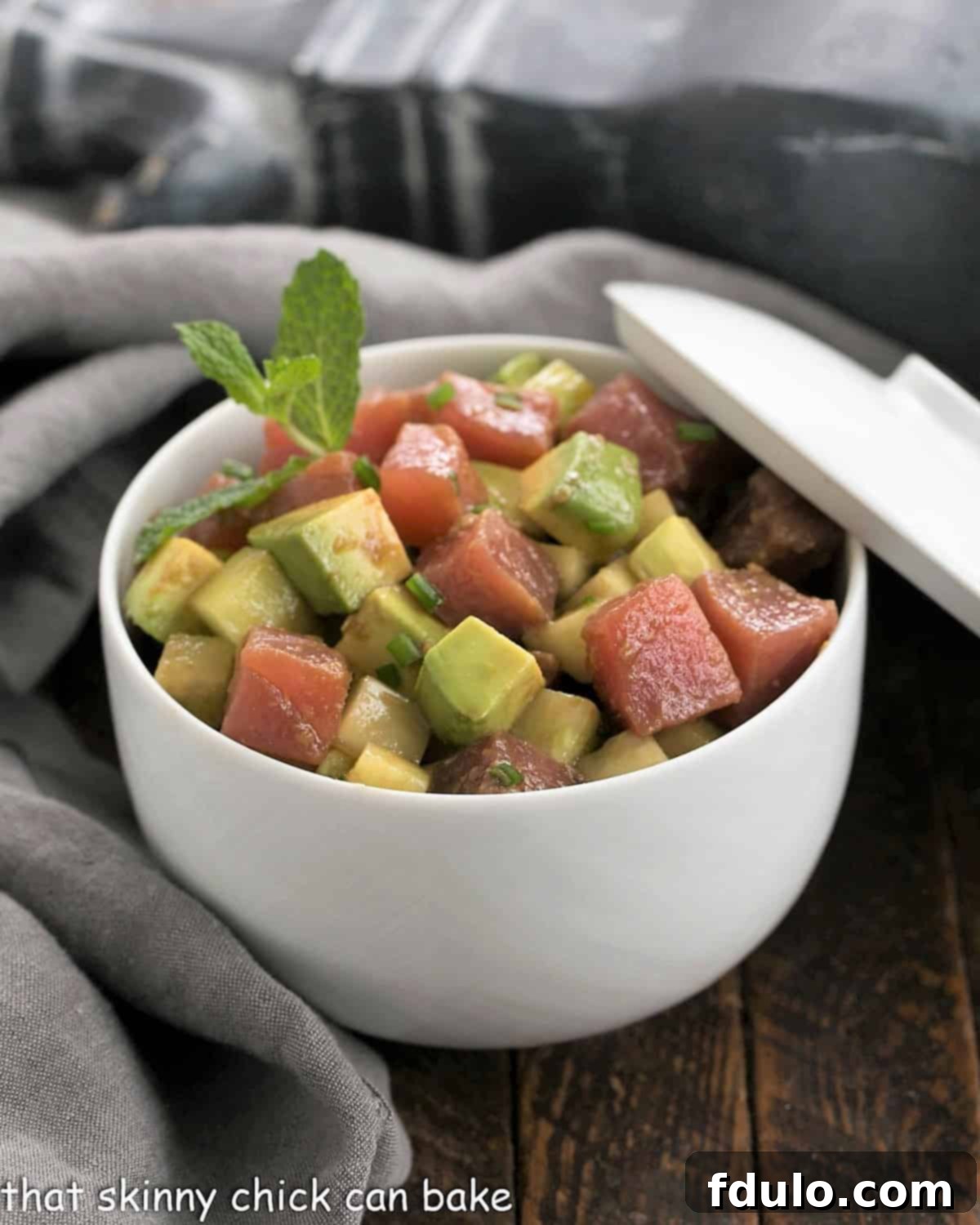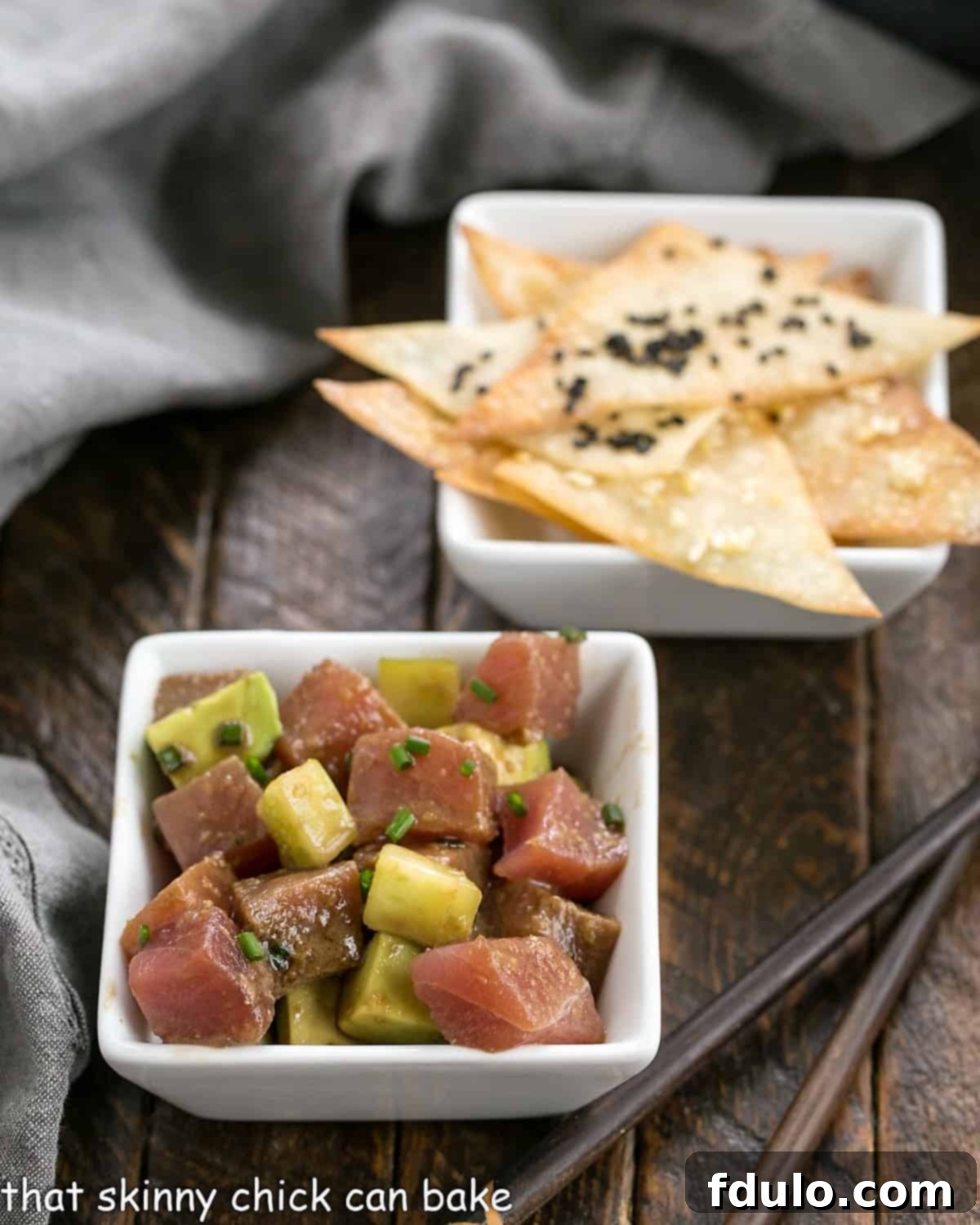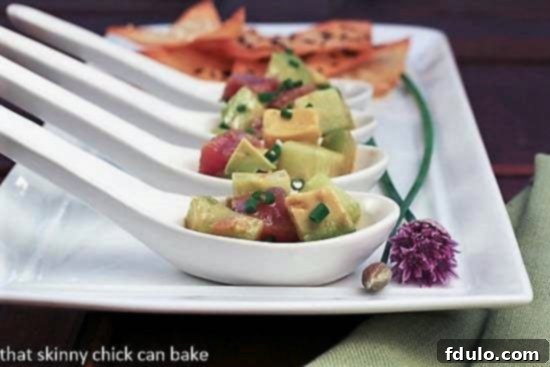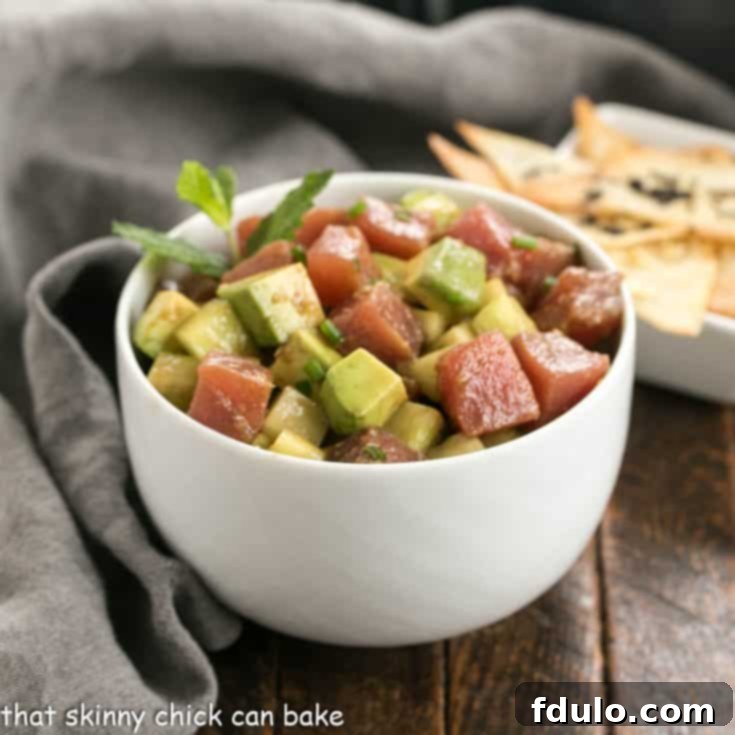Avocado Tuna Tartare is a truly spectacular appetizer that stands out from the crowd. Offering a delightful blend of fresh tuna, crisp cucumber, creamy avocado, and a vibrant Asian dressing, this dish promises an exceptional culinary experience. It’s surprisingly simple to prepare, yet sophisticated enough to impress at any gathering, making it a favorite for both casual and elegant occasions.
This exquisite Ahi Tuna Tartare is the epitome of an easy appetizer, demanding no cooking whatsoever—just a bit of precise dicing and a quick whisking of the dressing. Its inherent elegance makes it a perfect addition to your recipe repertoire, especially when you’re looking to entertain guests with something both light and deeply flavorful. Imagine the vibrant colors and fresh textures coming together to create an unforgettable starter that’s both healthy and incredibly satisfying.

Why Avocado Tuna Tartare Should Be Your Next Appetizer
If you’ve ever savored the delicate flavors of tuna tartare at a high-end restaurant, you know it’s a dish that leaves a lasting impression. The good news is, you can recreate that gourmet experience right in your own kitchen for a mere fraction of the cost, without sacrificing an ounce of quality or taste. Here’s why this Avocado Tuna Tartare recipe is an absolute must-try:
- Gourmet Dining at Home: Indulge in a luxurious appetizer typically found on upscale menus, but prepared effortlessly in your home. Making it yourself not only saves money but also allows you to control the freshness and quality of every ingredient.
- Perfect for Entertaining: When hosting dinner parties, finding a starter that’s impressive yet manageable can be a challenge. This tuna tartare is ideal because it’s visually stunning, incredibly delicious, and can be prepped largely in advance, freeing you up to enjoy your guests. Its vibrant colors and sophisticated presentation will undoubtedly be a conversation starter.
- A Powerhouse of Nutrition: Beyond its incredible taste, tuna tartare is remarkably healthy. It’s naturally low in carbs, packed with lean protein from the Ahi tuna, and rich in healthy fats from the avocado (omega-3s are vital for heart and brain health!). The fresh cucumber adds a hydrating crunch and essential vitamins, making it a guilt-free indulgence that nourishes your body.
- Effortless Preparation: Unlike many impressive dishes, this recipe requires absolutely no cooking. It’s all about fresh ingredients, precise dicing, and assembling. This means less time over a hot stove and more time enjoying your company or relaxing.
- Unique Flavor Profile: The harmonious blend of savory tuna, creamy avocado, crisp cucumber, and a zesty Asian dressing creates a symphony of flavors and textures. The dressing, with hints of soy, sesame, citrus, and wasabi, elevates the entire dish, offering a delightful balance of umami, tang, and a subtle kick.

Simple Steps to Crafting Perfect Tuna Tartare
Creating this delicious Avocado Tuna Tartare is a straightforward process, focusing on fresh ingredients and careful assembly. Here’s a detailed guide to help you achieve a restaurant-quality appetizer at home:
- Prepare Homemade Wonton Crisps (Optional but Recommended): For an authentic touch, consider making your own wonton chips. Simply brush triangular cuts of egg roll wrappers with a light coating of olive oil, sprinkle generously with sesame seeds, and bake until golden and crisp. While sesame seeds may not always adhere perfectly, the flavor they impart is worth the effort. Alternatively, you can use store-bought wonton crisps, rice crackers, or even fresh cucumber slices for a gluten-free option.
- Precise Dicing is Key: The beauty of tartare lies in its uniform texture. Carefully dice your sushi-grade Ahi tuna, ripe avocado, and crisp English cucumber into roughly ⅓-inch cubes. Consistency in size ensures an even distribution of flavors and makes the dish easier and more pleasant to eat.
- Whisk the Asian Dressing: In a small bowl, whisk together the ingredients for the vibrant Asian dressing. This typically includes soy sauce for umami, unseasoned rice vinegar for tang, fresh lemon juice for brightness, a touch of wasabi paste for a subtle kick, and toasted sesame oil for its distinctive nutty aroma. Whisk until well combined and emulsified.
- Gently Combine Ingredients: In a medium mixing bowl, add the diced tuna, avocado, cucumber, and freshly chopped chives. Pour the prepared dressing over these ingredients. Using a gentle hand, carefully toss everything together. The goal is to coat all components evenly without mashing the delicate tuna or avocado.
- Perfect Your Presentation: Once combined, you can serve the tartare immediately or chill it slightly. Present it elegantly with your homemade wonton crisps on the side. For an added touch of freshness and visual appeal, sprinkle with extra chopped chives and a few more sesame seeds just before serving.
- Maintain Optimal Temperature: Since this dish features raw fish and fresh ingredients, it’s crucial to keep your tuna tartare well-chilled in the refrigerator until you are ready to serve. This not only preserves its freshness and safety but also enhances the refreshing quality of the appetizer.

Photo circa 2012
Expert Tips for an Unforgettable Tuna Tartare
My first encounter with tuna tartare was years ago at Todd English’s Olives in Aspen, Colorado. My husband and I were enjoying a rare night out during a family vacation, and while the entire dinner was lovely, it was the appetizer that truly captivated me. I fell utterly in love with the fresh, vibrant flavors and delicate textures. That memory sparked a mission to recreate that magic at home, specifically recalling a recipe that featured both sesame oil and sesame seeds – a combination that spoke to me. Crafting that dish for myself, I savored every single bite, realizing the joy of bringing such a gourmet experience into my own kitchen. To help you achieve the same success, here are some expert tips:
- Timing is Everything for Presentation: If you’re preparing this for company, avoid mixing the dressing with the tuna and avocado too far in advance. The soy sauce in the dressing can cause the vibrant colors of the ingredients, especially the tuna, to mute or darken over time. While the flavor actually deepens and often tastes even better the next day (making it perfect for personal enjoyment!), for a visually striking presentation, aim to combine the tartare with the dressing within an hour or two of serving. However, do allow at least 30 minutes to an hour in the refrigerator for the flavors to meld beautifully.
- Uniform Dicing for Perfect Texture: As mentioned, cut all components—tuna, avocado, and cucumber—into similar-sized cubes, ideally around ⅓ inch. This uniformity is crucial for two reasons: it makes each bite a harmonious blend of textures and flavors, and it significantly enhances the overall eating experience. Uneven pieces can lead to an inconsistent mouthfeel.
- Source High-Quality Sushi-Grade Tuna: Since this dish is served raw, the quality and freshness of your tuna are paramount. Always purchase your Ahi tuna from a reputable fishmonger or a trusted seafood counter that explicitly labels it as “sushi-grade” or “sashimi-grade.” This indicates it’s safe for raw consumption. Don’t hesitate to ask your fishmonger about the fish’s origin and when it was caught.
- Keep it Chilled: Raw seafood must be kept cold for both safety and optimal texture. Ensure your tuna tartare remains well-chilled in the refrigerator until the very moment you serve it. This maintains its refreshing quality and prevents any bacterial growth.
- Ripeness of Avocado: Use an avocado that is perfectly ripe—soft enough to mash slightly but still firm enough to hold its diced shape. An underripe avocado will be hard and flavorless, while an overripe one will be mushy.
- Customize Your Wasabi: The amount of wasabi paste in the dressing can be adjusted to your personal heat preference. Start with a smaller amount and add more gradually until you reach your desired level of spiciness.
- Creative Presentation Ideas: For a professional touch, use a ring mold to shape individual servings of tartare on plates. You can also serve it in elegant Asian spoons for a bite-sized presentation, or simply in a communal bowl with crisps arranged around it.
- Consider Variations: Feel free to experiment with additional ingredients. Finely diced mango can add a touch of sweetness and tropical flavor, while a hint of fresh ginger or a sprinkle of toasted black sesame seeds can further enhance the Asian profile.
Frequently Asked Questions About Tuna Tartare
“Sushi Grade” is a term commonly used by seafood wholesalers and retailers to denote the highest quality of seafood that they consider safe for raw consumption. It implies that the fish has been handled with extreme care, promptly frozen to eliminate parasites, and maintained at optimal temperatures. However, it’s important to understand that, unlike beef (which has a USDA grading system), there isn’t a universally recognized, official governing body that grades fish as “sushi-grade.” Therefore, it’s crucial to purchase your seafood from a source with an impeccable reputation for freshness, hygiene, and traceability. Ask your fishmonger questions about how the fish was caught, handled, and stored.
The term “tartare” generally refers to a dish made from seasoned raw ground meat or seafood, often shaped into a patty or mound. The most famous precursor is Steak Tartare. Tuna Tartare itself was reportedly invented in 1984 by Chef Shigefumi Tachibe at the legendary restaurant Chaya Brasserie in Los Angeles. Chef Tachibe, a French-trained Japanese chef, coined the term “tuna tartare” to honor his classical culinary background and draw a parallel to the traditional French dish while using a different star ingredient: fresh Ahi tuna.
Eating raw tuna can be generally safe when sourced and handled correctly. The primary concern with raw fish is parasites and bacteria. Reputable suppliers often freeze their fish to very low temperatures, a process known as “flash freezing,” which effectively eliminates most parasites. Always ensure you are buying “sushi-grade” or “sashimi-grade” tuna from a trusted fishmonger. However, it is generally not recommended to serve raw seafood to individuals who are very young, elderly, pregnant, or immune-compromised, as their systems may be more vulnerable to potential pathogens.
Wasabi, also known as Japanese horseradish (Wasabia japonica), is a pungent green condiment famous for its sharp, fiery, and rapidly dissipating heat. Unlike chili heat, wasabi’s spiciness tends to hit the nasal passages rather than linger on the tongue. It’s often described as clean and refreshing. According to The Food Lover’s Companion, it delivers a unique kick that complements seafood beautifully. Authentic wasabi comes from the grated rhizome (root-like stem) of the wasabi plant, which is notoriously difficult to cultivate. Most wasabi paste or powder available outside of high-end Japanese restaurants is actually a blend of horseradish, mustard, and green food coloring, offering a similar but less nuanced flavor profile. Both forms work well in the tartare dressing.
Ahi tuna, specifically Yellowfin tuna, is overwhelmingly the preferred choice for tuna tartare. Its firm texture, mild flavor, and vibrant red color make it ideal for raw preparations. Bigeye tuna is another excellent option. Avoid albacore tuna for tartare, as it has a firmer, drier texture and a stronger “fishy” flavor that is better suited for cooking or canning.
For optimal safety and quality, tuna tartare should be consumed on the day it is prepared. While it can be stored in an airtight container in the refrigerator for up to 24 hours, the quality of the raw fish and fresh avocado will diminish, and the tuna may darken due to the soy sauce. It is best enjoyed fresh.
Explore More Delicious Seafood Recipes
If you’re a fan of fresh Ahi tuna and delightful seafood dishes, you’ll love exploring some of our other recipes. From light lunches to comforting dinners, we have something for every seafood enthusiast.
- Check out my Ahi Tuna Nicoise for a wonderful and vibrant lunch or dinner option that’s both hearty and healthy!
- Tuna Salad with Fresh Dill: A classic comfort elevated with fresh herbs.
- Tuna Casserole from Scratch: Reimagining a nostalgic dish with homemade goodness.
- Easy Glazed Salmon: A quick and flavorful weeknight dinner.
- Fresh Salmon Cakes: A delightful way to enjoy salmon with a homemade remoulade.
- Plus, don’t miss all my Favorite Seafood Recipes for endless inspiration!
Stay in touch through social media @ Instagram, Facebook, and Pinterest. Don’t forget to tag me when you try one of my recipes! And if you love the results, please give it a 5-star rating in the recipe card.

Tuna Avocado Tartare
10 minutes
9 minutes
19 minutes
6 servings
An Asian-inspired appetizer featuring vibrant avocados, crisp cucumbers, fresh Ahi tuna, and aromatic chives, all brought together with a zesty dressing!
Ingredients
- 12 wonton wrappers, cut in half on the diagonal
- Olive oil
- Sesame seeds
- 2 tablespoons soy sauce
- 1 tablespoon unseasoned rice vinegar
- 1 tablespoon fresh lemon juice
- 1 ½ teaspoons wasabi paste
- ¾ teaspoon toasted sesame oil
- 8 ounces sushi-grade Ahi tuna, cut into ⅓-inch cubes
- 1 avocado, cut into ⅓-inch cubes
- 1 cup cubed English cucumber (peeled and cut into ⅓-inch cubes)
- Chopped fresh chives
Instructions
- Preheat oven to 350ºF (175ºC). Line a baking sheet with parchment paper and arrange the wonton triangles on the pan. Lightly brush with olive oil and sprinkle with sesame seeds if desired.
- Bake for approximately 9 minutes, or until golden brown and crisp. Allow to cool completely on the baking sheet.
- In a small bowl, whisk together the soy sauce, rice vinegar, fresh lemon juice, wasabi paste, and toasted sesame oil until thoroughly combined.
- In a larger bowl, gently combine the diced Ahi tuna, avocado, cucumber, and chopped fresh chives. Pour the whisked dressing over the mixture.
- Carefully stir to combine all ingredients, ensuring they are evenly coated without mashing the delicate components. Serve immediately with the wonton crisps. Garnish with additional chives and sesame seeds if desired for extra flair.
Notes
If you are making this for a special occasion or guests and presentation is key, avoid mixing the tartare with the dressing too far in advance, as the soy sauce can cause the tuna’s color to darken. However, for personal enjoyment, the flavors actually meld beautifully and often taste even better the next day, so don’t hesitate to prepare it ahead if you’re not concerned about color preservation. This recipe is adapted from Bon Appetit. For a gluten-free option, serve with cucumber slices or rice crackers instead of wonton crisps.
Recommended Products
As an Amazon Associate and member of other affiliate programs, I earn from qualifying purchases.
- USA Pan Bakeware Half Sheet Pan
- Santoku Knife
- OXO Cutting Board
Nutrition Information:
Yield:
6
Serving Size:
1
Amount Per Serving:
Calories: 244Total Fat: 14gSaturated Fat: 2gTrans Fat: 0gUnsaturated Fat: 11gCholesterol: 11mgSodium: 546mgCarbohydrates: 22gFiber: 4gSugar: 2gProtein: 9g
HOW MUCH DID YOU LOVE THIS RECIPE?
Please leave a comment on the blog or share a photo on Pinterest
